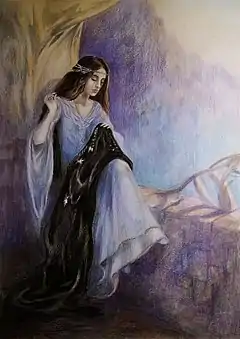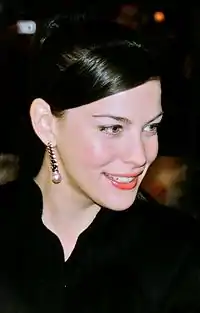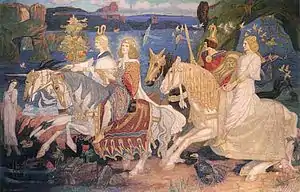Arwen
Arwen Undómiel is a fictional character in J. R. R. Tolkien's Middle-earth legendarium. She appears in the novel The Lord of the Rings. Arwen is one of the half-elven who lived during the Third Age; her father was Elrond half-elven, a descendant of the Man Tuor, while her mother was the Elf Celebrian, daughter of the Elf-queen Galadriel. In the novel, she marries the Man Aragorn, who becomes King of Arnor and Gondor, thus adding long life and nobility to his dynasty.
| Arwen | |
|---|---|
| Tolkien character | |
 Arwen sewing Aragorn's banner of the White Tree of Gondor by Anna Kulisz, inspired by Edmund Leighton's 1911 Stitching the Standard | |
| In-universe information | |
| Race | Half-elven |
| Book(s) | The Fellowship of the Ring (1954) The Return of the King (1955) Unfinished Tales (1980) |
In Peter Jackson's film adaptation, Arwen is played by Liv Tyler.
Literature
Arwen was the youngest child of Elrond and Celebrían. Her elder brothers were the twins Elladan and Elrohir. Her name "Ar-wen" means 'noble maiden' in Sindarin. She bore the soubriquet "Evenstar" (Evening Star), as the most beautiful of the last generation of High Elves in Middle-earth.
But Aragorn answered: "Alas! I cannot foresee it, and how it may come to pass is hidden from me. Yet with your hope I will hope. And the Shadow I utterly reject. But neither, lady, is the Twilight for me; for I am mortal, and if you will cleave to me, Evenstar, then the Twilight you must also renounce."
J.R.R. Tolkien, The Lord of the Rings, Appendix A, part I (v) The Tale of Aragorn and Arwen
As told in "The Tale of Aragorn and Arwen", Aragorn in his twentieth year met Arwen for the first time in Rivendell, where he lived under Elrond's protection. Arwen, then over 2,700 years old, had recently returned to her father's home after living with her grandmother, the elf-queen Galadriel in Lothlórien. Aragorn fell in love with Arwen at first sight. 30 years later, the two were reunited in Lórien. Arwen reciprocated Aragorn's love, and on the mound of Cerin Amroth they committed themselves to marry each other. In making that choice, Arwen gave up the Elvish immortality available to her as a daughter of Elrond and agreed to remain in Middle-earth instead of traveling to the Undying Lands.[T 1]
Arwen first appears in the text of The Lord of the Rings in Rivendell, shortly after Frodo Baggins wakes in the House of Elrond: she sits beside her father at the celebratory feast.[T 2] When the Fellowship of the Ring comes to Lothlórien, Aragorn remembers his earlier meeting with Arwen and pauses in reverence.[T 3]
Shortly before Aragorn takes the Paths of the Dead, he is joined by a contingent of his people accompanied by Arwen's brothers, Elladan and Elrohir, who bring him a gift from Arwen: a banner of black cloth.[T 4] The banner is unfurled at the Battle of the Pelennor Fields to reveal the emblem of Elendil figured in mithril, gems, and gold; this becomes the first triumphant public announcement of the king's return.[T 5]
After the ring is destroyed, Aragorn becomes king of Arnor and Gondor. Arwen arrives at Minas Tirith, and they are married.[T 6] She gives Frodo the Evenstar: her necklace with a white stone, to aid him when his injuries trouble him.[T 7]
Arwen is a minor character in The Lord of the Rings, but she serves as inspiration and motivation for Aragorn, who must become King of both Arnor and Gondor before Elrond will allow her to marry him.[T 1] The Tale of Aragorn and Arwen, an appendix to the main story, relates that Aragorn and Arwen had a son, Eldarion, and at least two unnamed daughters. One year after Aragorn's death, Arwen dies at the age of 2,901.[T 1]
Background
Through her father, Elrond, Arwen was the granddaughter of Eärendil the Mariner (the second of the Half-elven), great-granddaughter of Tuor of Gondolin, and therefore a direct descendant of the ancient House of Hador. Through her great-grandmother, Idril, Arwen was also a descendant of King Turgon of the Noldor. Through her mother, she was the granddaughter of the Elf-queen Galadriel of Lothlórien, and the great-granddaughter of Finarfin.[T 8] Éomer of Rohan said that the Lady Arwen was fairer than Galadriel, but Gimli son of Glóin thought differently.[T 7] Through both of her parents, Arwen was a direct descendant of the ancient Elven House of Finwë. Furthermore, Arwen was a descendant of Beren and Lúthien, whose story resembled hers. Indeed, Arwen was held to be the reappearance in likeness of her ancestor Lúthien, fairest of all the Elves, who was called Nightingale (Tinúviel).[T 1]
Arwen was a distant relative of her husband Aragorn.[T 1] Aragorn's ancestor, Elros Tar-Minyatur, the first King of Númenor, was her father Elrond's brother, who chose to live as a Man rather than as one of the Eldar. Arwen eventually became Queen of the Reunited Kingdom of Arnor and Gondor when she married Aragorn, who was of the line of the Kings of Arnor. By Arwen and Aragorn's marriage, the long-sundered lines of the Half-elven were joined. Their union also served to unite and preserve the bloodlines of the Three Kings of the High Elves (Ingwë, Finwë, and the brothers Olwë and Elwë) as well as the only line with Maiarin blood through Arwen's great-great-great grandmother, Melian, Queen of Doriath, and also on Aragorn's side, through the line of kings of Arnor and Númenor to Elros, Elrond's brother, whose great-great-grandmother was also Melian.[T 9]
| Half-elven family tree[T 10][T 11] | |||||||||||||||||||||||||||||||||||||||||||||||||||||||||||||||||||||||||||||||||||||||||||||||||||||||||||||||||||||||||||||||||||||||||||||||||||||||||||||||||||||||||||||||||||||||||||||||||||||||||||||||||||||||||||||||||||||||||||||||||||||||||||||||||||||||||||||||||||||||||||||||||||||||||||||||||||||||||||||||||||||||||||||||||||||||||||||||||||||||||||||||||||||||||||||||||||||||||||||||||||||||||||||||||||||||||||||||||||||||||||||||||||||||||||||||||||||||||||||||||||||||||||||||||||||||||||||||||||||||||||||||||||||||||||||||||||||||||||||||||||||||||||||||||||||||||||||||||||||||||||||||||||||||||||||||||||||||||||||||||||||||||||||||||||||||||||||||||||||||||||||||||||||||||||||||||||||||||||||||||||||||||||||||||||||||||||||||||||||||||||||||||||||||||||||||||||||||||||||||||||||||||||||||||||||||||||||||||||||||||||||||||||||||||||||||||||||||||||||||||||||||||||||||||||||||||||||||||||||||||||||||||||||||||||||||||||||||||||||||||||||||||||||||||||||||||||||||||||||||
|---|---|---|---|---|---|---|---|---|---|---|---|---|---|---|---|---|---|---|---|---|---|---|---|---|---|---|---|---|---|---|---|---|---|---|---|---|---|---|---|---|---|---|---|---|---|---|---|---|---|---|---|---|---|---|---|---|---|---|---|---|---|---|---|---|---|---|---|---|---|---|---|---|---|---|---|---|---|---|---|---|---|---|---|---|---|---|---|---|---|---|---|---|---|---|---|---|---|---|---|---|---|---|---|---|---|---|---|---|---|---|---|---|---|---|---|---|---|---|---|---|---|---|---|---|---|---|---|---|---|---|---|---|---|---|---|---|---|---|---|---|---|---|---|---|---|---|---|---|---|---|---|---|---|---|---|---|---|---|---|---|---|---|---|---|---|---|---|---|---|---|---|---|---|---|---|---|---|---|---|---|---|---|---|---|---|---|---|---|---|---|---|---|---|---|---|---|---|---|---|---|---|---|---|---|---|---|---|---|---|---|---|---|---|---|---|---|---|---|---|---|---|---|---|---|---|---|---|---|---|---|---|---|---|---|---|---|---|---|---|---|---|---|---|---|---|---|---|---|---|---|---|---|---|---|---|---|---|---|---|---|---|---|---|---|---|---|---|---|---|---|---|---|---|---|---|---|---|---|---|---|---|---|---|---|---|---|---|---|---|---|---|---|---|---|---|---|---|---|---|---|---|---|---|---|---|---|---|---|---|---|---|---|---|---|---|---|---|---|---|---|---|---|---|---|---|---|---|---|---|---|---|---|---|---|---|---|---|---|---|---|---|---|---|---|---|---|---|---|---|---|---|---|---|---|---|---|---|---|---|---|---|---|---|---|---|---|---|---|---|---|---|---|---|---|---|---|---|---|---|---|---|---|---|---|---|---|---|---|---|---|---|---|---|---|---|---|---|---|---|---|---|---|---|---|---|---|---|---|---|---|---|---|---|---|---|---|---|---|---|---|---|---|---|---|---|---|---|---|---|---|---|---|---|---|---|---|---|---|---|---|---|---|---|---|---|---|---|---|---|---|---|---|---|---|---|---|---|---|---|---|---|---|---|---|---|---|---|---|---|---|---|---|---|---|---|---|---|---|---|---|---|---|---|---|---|---|---|---|---|---|---|---|---|---|---|---|---|---|---|---|---|---|---|---|---|---|---|---|---|---|---|---|---|---|---|---|---|---|---|---|---|---|---|---|---|---|---|---|---|---|---|---|---|---|---|---|---|---|---|---|---|---|---|---|---|---|---|---|---|---|---|---|---|---|---|---|---|---|---|---|---|---|---|---|---|---|---|---|---|---|---|---|---|---|---|---|---|---|---|---|---|---|---|---|---|---|---|---|---|---|---|---|---|---|---|---|---|---|---|---|---|---|---|---|---|---|---|---|---|---|---|---|---|---|---|---|---|---|---|---|---|---|---|---|---|---|---|---|---|---|---|---|---|---|---|---|---|---|---|---|---|---|---|---|---|---|---|---|---|---|---|---|---|---|---|---|---|---|---|---|---|---|---|---|---|---|---|---|---|---|---|---|---|---|---|---|---|---|---|---|---|---|---|---|---|---|---|---|---|---|---|---|---|---|---|---|---|---|---|---|---|---|---|---|---|---|---|---|---|---|---|---|---|---|---|---|---|---|---|---|---|---|---|---|---|---|---|---|---|---|---|---|---|---|---|---|---|---|---|---|---|---|---|---|---|---|---|---|---|---|---|---|---|---|---|---|---|---|---|---|---|---|---|---|---|---|---|---|---|---|---|---|---|---|---|---|---|---|---|---|---|---|---|---|---|---|---|---|---|---|---|---|---|---|---|---|---|---|---|---|---|---|---|---|---|---|---|---|---|---|---|---|---|---|---|---|---|---|---|---|---|---|---|---|---|---|---|---|---|---|---|---|---|---|---|---|---|---|---|---|---|---|---|---|---|---|---|---|---|---|---|---|---|---|---|---|---|---|---|---|---|---|---|---|---|---|---|---|---|---|---|---|---|---|---|---|---|---|---|---|---|---|---|---|---|---|---|---|---|---|---|---|---|---|---|---|---|---|---|---|---|---|---|---|---|---|---|---|---|---|---|---|---|---|---|---|---|---|---|---|---|---|---|---|---|---|---|---|---|---|---|---|---|---|---|---|---|---|---|---|---|---|---|---|---|---|---|---|---|---|---|---|---|---|---|---|---|---|---|---|---|---|---|---|---|---|---|---|---|---|---|---|---|---|---|---|---|---|---|---|---|---|---|---|---|---|---|---|---|---|---|---|---|---|---|---|---|---|---|
| |||||||||||||||||||||||||||||||||||||||||||||||||||||||||||||||||||||||||||||||||||||||||||||||||||||||||||||||||||||||||||||||||||||||||||||||||||||||||||||||||||||||||||||||||||||||||||||||||||||||||||||||||||||||||||||||||||||||||||||||||||||||||||||||||||||||||||||||||||||||||||||||||||||||||||||||||||||||||||||||||||||||||||||||||||||||||||||||||||||||||||||||||||||||||||||||||||||||||||||||||||||||||||||||||||||||||||||||||||||||||||||||||||||||||||||||||||||||||||||||||||||||||||||||||||||||||||||||||||||||||||||||||||||||||||||||||||||||||||||||||||||||||||||||||||||||||||||||||||||||||||||||||||||||||||||||||||||||||||||||||||||||||||||||||||||||||||||||||||||||||||||||||||||||||||||||||||||||||||||||||||||||||||||||||||||||||||||||||||||||||||||||||||||||||||||||||||||||||||||||||||||||||||||||||||||||||||||||||||||||||||||||||||||||||||||||||||||||||||||||||||||||||||||||||||||||||||||||||||||||||||||||||||||||||||||||||||||||||||||||||||||||||||||||||||||||||||||||||||||||
Concept and creation
As related in The History of Middle-earth, Tolkien conceived the character of "Elrond's daughter" late in the writing.[T 12][T 13] Prior to this, he considered having Aragorn marry Éowyn of the royal family of Rohan.[T 14]
Arwen is depicted as extremely beautiful; she is in Melissa Hatcher's view in Mythlore "a symbol of the unattainable, a perfect match for the unattainable Aragorn in Éowyn's eyes."[1] Carol Leibiger wrote in the J.R.R. Tolkien Encyclopedia that Arwen's lack of involvement follows the general Elvish pattern of retreating to safe havens already established in The Silmarillion and continued in The Lord of the Rings.[2]
The scholar of English literature Nancy Enright wrote that Arwen, like Christ, is an immortal who voluntarily chooses mortality out of love, in her case for Aragorn. She granted that Arwen is not a conspicuous character, and unlike Éowyn does not ride into battle, but stated that her inner power is "subtly conveyed" and present throughout the novel.[3]
Adaptations

Arwen does not appear in Ralph Bakshi's 1978 adaptation of The Lord of the Rings, nor in the 1980 Rankin-Bass adaptation of The Return of the King.
In Peter Jackson's The Lord of the Rings film trilogy, Arwen is played by Liv Tyler. The films give her a more prominent role than her literary counterpart.[4][5][6] In the first film, Arwen searches for Aragorn and single-handedly rescues Frodo Baggins from the Black Riders at Bruinen, thwarting them with a sudden flood, summoned by an incantation. (In the novel, Elrond summons the flood, and Glorfindel takes Frodo to Rivendell.) During this flight Arwen wields the sword Hadhafang, which according to film merchandise was once wielded by her father and had belonged to his grandmother Idril Celebrindal.[7][6]
In the film adaptation of The Two Towers, the injured Aragorn is revived by a dream or vision of Arwen, who kisses him and asks the Valar to protect him.[6]

In the extended version, Elrond asks Arwen, in Elvish with English subtitles, to accompany him to safety in Valinor, away from Middle-earth.[9]
In the film, instead of Arwen sending Aragorn the banner she has made, Elrond takes the sword Narsil, reforged as Andúril, to Aragorn at Dunharrow, and tells him that Arwen's fate has become bound to the One Ring, and that she is dying. The critic Janet Brennan Croft comments that Arwen is made passive and is not allowed independence of mind; from being a constant support, she is a distraction, even a temptation, to the American Superhero, and their marriage, in the book a sign of his rightful kingship, is in the film something he accepts as if he was condemned to it.[10] [11]
The critic Dimitra Fimi comments that the procession of Elves in the scene "Arwen's vision" in the extended version borrows visually from the "Celtic" imagery of John Duncan's 1911 Pre-Raphaelite painting Riders of the Sidhe.[8] Sauron uses the Palantír to show Aragorn a dying Arwen (a scene from the future) in the hope of weakening his resolve.[10]
The movies portray Arwen as becoming human through her love for Aragorn; as in the novel, she follows the choice of her ancestor Lúthien to become a mortal woman for the love of a mortal man.[6] The movies introduce a jeweled pendant called the Evenstar which Arwen gives to Aragorn as a token of their love. A similar pendant appears in the short story The Jewel of Arwen by Marion Zimmer Bradley, although in that story Arwen gives it to "the Ring-Bearer" rather than to Aragorn.[lower-alpha 1] In Tolkien's novel, Arwen gives Frodo "a white gem like a star...hanging upon a silver chain" before he leaves Minas Tirith, saying, "When the memory of the fear and the darkness troubles you...this will bring you aid".[T 7]
In earlier versions of the script, Arwen fought in the Battle of Helm's Deep and brought the sword Andúril to Aragorn. Some scenes of Arwen fighting in Helm's Deep were filmed before both the film's writers (with Liv Tyler's approval) reconsidered the change and deleted her from the sequence.[12] The critic John D. Rateliff comments on the deletion of what he calls "Arwen, Warrior Princess" that it was a wise decision, though "at the cost of reducing her to a sort of Lady of Shallott languishing for most of the final two films".[13]
In the musical theatre adaptation of Lord of the Rings, Arwen, played by Rosalie Craig, sings the Prologue, as well as three musical numbers: "The Song of Hope", "Star of Eärendil" (with the Elven chorus) and "The Song of Hope Duet" (with Aragorn).[14][15]
In the 2009 fan film The Hunt for Gollum, Arwen is played by Rita Ramnani.[16][17]
In the Mythopoeic Society's Tolkien on Film: Essays on Peter Jackson's The Lord of the Rings, Cathy Akers-Jordan, Victoria Gaydosik, Jane Chance, and Maureen Thum all contend that the portrayal of Arwen and other women in the Jackson films is thematically faithful to or compatible with Tolkien's writings, despite the differences.[18][19][20][21]
John Howe's rendition of Arwen for the Lord of the Rings board game was inspired by French actress Isabelle Adjani.[22]
Namesakes
The International Astronomical Union names all colles (small hills) on Saturn's moon Titan after characters in Tolkien's work.[23] In 2012, they named a hilly area "Arwen Colles" after Arwen.[24]
Notes
- This story appears in all the fantasy trilogies in the ISFDB list.
References
Primary
- This list identifies each item's location in Tolkien's writings.
- The Return of the King, Appendix A, part I (v) "The Tale of Aragorn and Arwen"
- The Fellowship of the Ring, book 2, ch. 2 "The Council of Elrond"
- The Fellowship of the Ring, book 2, ch. 6 "Lothlórien"
- The Return of the King, book 5, ch. 2 "The Passing of the Grey Company"
- The Return of the King, book 5, ch. 6 "The Battle of the Pelennor Fields"
- The Return of the King, book 6, ch. 5 "The Steward and the King"
- The Return of the King, book 6, ch. 6 "Many Partings"
- The Silmarillion, "Of the Rings of Power and the Third Age": Family Trees I and II: "The house of Finwë and the Noldorin descent of Elrond and Elros", and "The descendants of Olwë and Elwë"
- The Return of the King, Appendix A: Annals of the Kings and Rulers, I The Númenórean Kings
- Tolkien, J. R. R. (1977), Christopher Tolkien (ed.), The Silmarillion, Boston: Houghton Mifflin, "Of the Rings of Power and the Third Age": Family Trees I and II: "The house of Finwë and the Noldorin descent of Elrond and Elros", and "The descendants of Olwë and Elwë", ISBN 0-395-25730-1
- Tolkien, J. R. R. (1955), The Return of the King, The Lord of the Rings, Boston: Houghton Mifflin (published 1987), Appendix A: Annals of the Kings and Rulers, I The Númenórean Kings, ISBN 0-395-08256-0
- Tolkien, J. R. R. (1990), Christopher Tolkien (ed.), The War of the Ring, Boston: Houghton Mifflin, ISBN 0-395-56008-X
- Tolkien, J. R. R. (1992), Christopher Tolkien (ed.), Sauron Defeated, Boston, New York, & London: Houghton Mifflin, ISBN 0-395-60649-7
- Tolkien, J. R. R. (1989), Christopher Tolkien (ed.), The Treason of Isengard, Boston: Houghton Mifflin, ISBN 0-395-51562-9
Secondary
- Hatcher, Melissa McCrory (2007). "Finding Woman's Role in The Lord of the Rings". Mythlore. 25 (3). article 5.
- Leibiger, Carol A. (2013) [2007]. "Women in Tolkien's Works". In Drout, Michael D. C. (ed.). J.R.R. Tolkien Encyclopedia. Routledge. pp. 710–712. ISBN 978-0-415-86511-1.
- Enright, Nancy (2007). "Tolkien's Females and the Defining of Power". Renascence. 59 (2): 93–108. doi:10.5840/renascence200759213. ISSN 0034-4346.
- "Liv Tyler Biography". People. p. 2. Archived from the original on 3 July 2008. Retrieved 23 June 2008.
- Burr, Ty (12 December 2001). "Liv and Let Liv". Entertainment Weekly. Archived from the original on 1 February 2009. Retrieved 8 January 2009.
- Shippey, Tom (2005) [1982]. The Road to Middle-Earth (Third ed.). HarperCollins. pp. 413, 418–419. ISBN 978-0261102750.
- Derdzinski, Ryszard (ed.). "Language in the Lord of the Rings movie". Retrieved 2 December 2012.
- Fimi, Dimitra (2011). Bogstad, Janice M.; Kaveny, Philip E. (eds.). Filming Folklore. Picturing Tolkien: Essays on Peter Jackson's The Lord of the Rings Film Trilogy. McFarland. p. 90. ISBN 978-0-7864-8473-7.
- Ford, Judy Ann; Reid, Robin Anne (2011). Bogstad, Janice M.; Kaveny, Philip E. (eds.). Into the West. Picturing Tolkien: Essays on Peter Jackson's The Lord of the Rings Film Trilogy. McFarland. p. 174. ISBN 978-0-7864-8473-7.
- Croft, Janet Brennan (2011). Bogstad, Janice M.; Kaveny, Philip E. (eds.). Jackson's Aragorn and the American Superhero. Picturing Tolkien: Essays on Peter Jackson's The Lord of the Rings Film Trilogy. McFarland. pp. 219–220. ISBN 978-0-7864-8473-7.
- Thompson, Kristin (2011). Bogstad, Janice M.; Kaveny, Philip E. (eds.). Gollum Talks to himself. Picturing Tolkien: Essays on Peter Jackson's The Lord of the Rings Film Trilogy. McFarland. p. 41. ISBN 978-0-7864-8473-7.
- Peter Jackson. (2005). The Lord Of The Rings - The Two Towers - Extended Edition Appendices [DVD].
- Rateliff, John D. (2011). Bogstad, Janice M.; Kaveny, Philip E. (eds.). Two Kinds of Absence. Picturing Tolkien: Essays on Peter Jackson's The Lord of the Rings Film Trilogy. McFarland. pp. 65–66. ISBN 978-0-7864-8473-7.
- "The Lord of the Rings". The Guide to Musical Theatre. Retrieved 19 July 2020.
- "Lord of the Rings cast confirmed!". London Theatre. 15 January 2007. Retrieved 19 July 2020.
- "The Hunt for Gollum". British Council. Retrieved 19 July 2020.
- "The Hunt for Gollum, kortfilm fra 2009". FilmFront. Retrieved 19 July 2020.
- Akers-Jordan, Cathy (2005). "Fairy Princess or Tragic Heroine? The Metamorphosis of Arwen Undomiel in Peter Jackson's The Lord of the Rings Films". In Croft, Janet Brennan (ed.). Tolkien on Film: Essays on Peter Jackson's The Lord of the Rings. Mythopoeic Press. ISBN 1-887726-09-8.
- Chance, Jane (2005). "Tolkien's Women (and Men): The Films and the Books". In Croft, Janet Brennan (ed.). Tolkien on Film: Essays on Peter Jackson's The Lord of the Rings. Mythopoeic Press. ISBN 1-887726-09-8.
- Gaydosik, Victoria (2005). "The Transformation of Tolkien's Arwen and the Abandonment of the Psyche Archetype: The Lord of the Rings on the Page and on the Screen". In Croft, Janet Brennan (ed.). Tolkien on Film: Essays on Peter Jackson's The Lord of the Rings. East Lansing, Michigan: Mythopoeic Press. ISBN 1-887726-09-8.
- Thum, Maureen (2005). "The 'Sub-Subcreation' of Galadriel, Arwen, and Éowyn: Tolkien's Women and The Lord of the Rings". In Croft, Janet Brennan (ed.). Tolkien on Film: Essays on Peter Jackson's The Lord of the Rings. Mythopoeic Press. ISBN 1-887726-09-8.
- "Arwen". Illustrator John Howe. Retrieved 18 September 2012.
- International Astronomical Union. "Categories for Naming Features on Planets and Satellites". Gazetteer of Planetary Nomenclature. Accessed Dec 29, 2012.
- International Astronomical Union. "Arwen Colles". Gazetteer of Planetary Nomenclature. Accessed Nov 14, 2012.
Sources
- Tolkien, J. R. R. (1954), The Fellowship of the Ring, The Lord of the Rings, Boston: Houghton Mifflin (published 1987), ISBN 0-395-08254-4
- Tolkien, J. R. R. (1954), The Two Towers, The Lord of the Rings, Boston: Houghton Mifflin (published 1987), ISBN 0-395-08254-4
- Tolkien, J. R. R. (1955), The Return of the King, The Lord of the Rings, Boston: Houghton Mifflin (published 1987), ISBN 0-395-08256-0
- Tolkien, J. R. R. (1977), Christopher Tolkien (ed.), The Silmarillion, Boston: Houghton Mifflin, ISBN 0-395-25730-1
.jpg.webp)